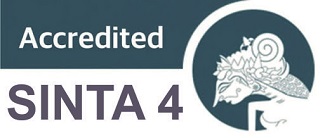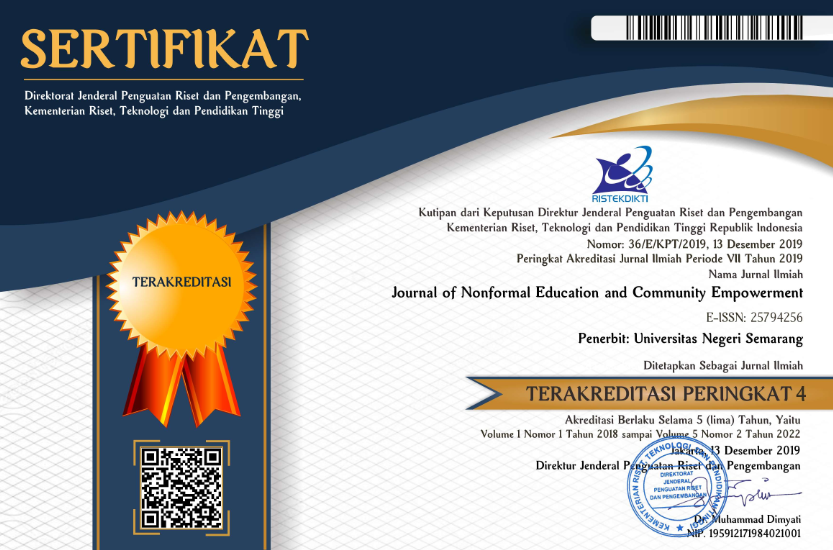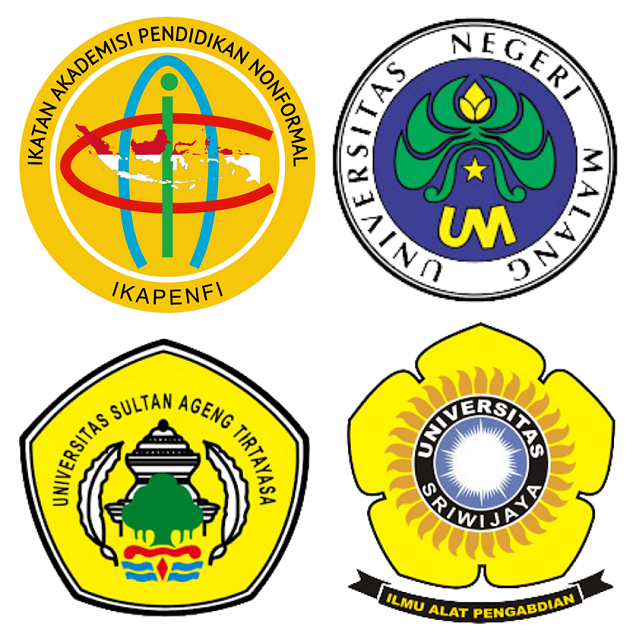
Author Guidelines
JOURNAL OF NONFORMAL EDUCATION AND COMMUNITY EMPOWERMENT
General Manuscript Writing Guidelines
Guidelines for the author of the manuscript can be described as follows.
a) Manuscripts written in Indonesian or English with 1.2 line spacing density, Calisto MT 10 font, A4 paper size, two column format, and last costum setting margin (top 2.7 cm; left 3 cm; bottom 3 cm; right 3 cm). This is in accordance with the article template that is available for download.
b) The length of the scientific manuscripts should be no more than 5000 words or approximately 10-15 pages, including any drawings, graphs or tables (if any) attached to them.
c) The terms in a foreign language or regional language in the text are written in italics .
d) Literature review is not included as part of the article structure. Thus the literature citations are considered important can be integrated in the introductory chapter (introduction) or under discussion. The citing of the literature in the discussion as necessary only and which is preferred is the discussion of the results of the analysis of the data found alone.
e) Scientific articles of the thesis, theses and dissertations of students to be published in scientific journals shall have a manuscript assessment sheet by the examiner (serving as a journal partner), certificate of receipt of the manuscript for the publication of the editorial board of journals attached to the manuscript and statement of transfer of rights create.
Scientific Article Structure
The structure of the research articles consists of 10 main parts: (1) title (2) line ownership; (3) abstract; (4) keywords; (5) introduction; (6) methods; (7) results and discussion; (8) conclusions; (9) acknowledgments and (10) bibliography. Each section is given an explanation as follows.
a) Title
1) The title should be concise and informative, with no more than 12 words, including the liaison. In order for the title to be short and succinct in 12 words, avoid conjuncture and mention of very detailed objects, places or research materials.
2) The title contains the key words of the topic under study.
3) Times New Roman 14 type font, with single line spacing.
4) Title in Indonesian or English, in accordance with the language used in the manuscript.
5) Avoid using abbreviations, formulas and references
b) Ownership (authorship lines)
1) The ownership line consists of two parts, namely author names and author institutional affiliation.
2) Student affiliation follows the place where the student is studying.
3) The names of authors should be those who actually participate in planning, execution, analysis of results, discussion, and report writing.
4) The academic / functional or bachelor degree must not be included.
5) The name of the institution is listed in full to the country name, written under the author's name along with the postal address, email and facsimile (if any) for the purposes of correspondence.
6) If the author is more than one person and comes from a different institutional, then all addresses are listed by giving a superscripts letter of the lowercase starting from a behind the author's name in sequence.
7) The name of the correspondence author is given an asterisk (*).
c) Abstract
1) Abstract is written in summary and factual, covering research objectives, research methods, results and conclusions
2) The abstract is written in one paragraph; written in two languages ​​(Bahasa Indonesia and English); abstract lengths ranging from 150 - 200 words.
3) Avoid unusual referrals and use of abbreviations.
d) Keywords
1) Keywords consist of 3 to 5 words and / or word groups
2) Written in alphabetical order
3) Between keywords separated by semicolons (;).
4) Avoid many connecting words (and, with, that and others).
e) Introduction
1) Avoid the sub-sub in the introduction.
2) Introduction should contain the background of problems, problems and research objectives.
3) Percentage of page length between 10-15% of the total length of a manuscript.
4) References are indicated by writing the author's family name / last name and year of issue, regardless of page number. The foundation of theory is presented in complete, concise, and completely relevant sentences for the purpose of writing scientific articles.
f) Research Methods
1) Inform briefly about the materials and methods used in the study, including the subjects / materials studied, the tools used, the design or experiment used, the sampling technique, the variables to be measured, the data retrieval technique, the analysis and the statistical model used.
2) Avoid writing excessive statistical formulas
3) If using a well-known method, name the method name only. If necessary, specify the reference source used as a reference.
4) For qualitative research, research methods can adjust. Results and Discussion
1) The format of the results of research and discussion is not separated, considering the number of pages available for the author is limited.
2) The results can be presented with support tables, graphics or images as needed, to clarify the presentation of results verbally.
3) Tables and charts or captions are arranged in the form of a phrase (not a sentence) succinctly.
4) Description of the image / graph is placed under the picture / graph, while the title of the table is placed on it. The title begins with a capital letter. The example can be seen in Figure 4.1.
Figure 1. Sample description of table and picture / graph
5) Do not repeat writing numbers that have been listed in the table in the text of the discussion. If it will emphasize the results obtained should serve in other forms, such as percentage or difference. To show the number in question, just refer to the table that contains the number.
6) In general international journals do not want statistical languages ​​(such as: differing support, treatment, dB) written in the discussion. Avoid copy and paste tables of statistical analysis results directly from statistical data processing software .
7) The discussion material mainly explores whether the results obtained in accordance with the hypothesis or not, and point out the argument.
8) Referral citation in the discussion should not be too long (if necessary avoid).
9) Citation results of research or opinions of others should be abstracted and written in the sentence itself (not using the exact same sentence).
10) A collection of similar research may be referred to in groups.
h) Conclusion
1) The conclusion should be the answer to the research question, and expressed not in statistical sentences.
2) Written along one paragraph in essay form, not in numerical form .
i) Acknowledgments
1) Acknowledgments are generally placed after the conclusion.
2) Contains gratitude to the funding agencies, and or individuals who have assisted in the execution of research and the writing of manuscripts
j) References
General provision of bibliography:
1) The references listed in the bibliography are only those references that are actually quoted in the manuscript.
2) For research articles, references are referenced from about 10-15 articles of scientific journals. While non-research articles have at least referenced 15 scientific articles
3) Updates of referenced scientific journals shall be considered, at least as a result of relevant publications in the last 10 years.
4) The bibliography is arranged alphabetically in alphabetical order of the author's name.
5) Author's name: the name shown is the final name (surname) of the author followed by the initial (and middle name) abbreviation if any). If the author is more than one person, then the way of writing is the same.
6) The writing of the reference title begins with a capital letter only at the beginning of the sentence.
7) Any writing of the name, year, title of the article and so on ends with a period (.) Before the next word continues. Special writing volume (number) journal is given a colon (:) without spacing. Examples of writing can be seen in the explanation of each type of literature worth mentioning.
Terms of referral writing by reference type:
1) If the library source is an article in a scientific journal, it is written in the following order: author's name. year. article title. the name of the journal. volume (number): page (Journal name is skewed).
Example:
Rahmathulla, VK, Das P., Ramesh, M. & Rajan, RK 2007. Growth rate pattern and economic traits of silkworm Bombyx mori, L under the influence of folic acid administration. J. Appl. Sci. Environ. Manage. 11 (4): 81-84
Wiryawan, KG, Luvianti, S., Hermana, W, & Suharti, S. 2007. Improved performance of broiler chicken with supplementation of bay leaf (Syzygium polyanturn) as antibacterial Escherichia coll. J. Livestock Media. 30 (1): 55-62
2) If the library source is a textbook, it is written in the following order: author name. year. book title. volume (if any). edition (if any). publisher city: publisher name (The title of the book is italicized).
Example:
Arikunto, S. 2002. The procedure of research is a practical approach. Jakarta: Rineka Cipta
Very, HM, Zuhud, EAM and Damayanti, EK 2000. Dictionary of diseases and medicinal plants (Etnofito medika). Jakarta: Yayasan Obor Indonesia
3) If the literature source is a translation book written following the sequence: the original author's name. years of translation. title of translation book. volume (if any). edition (if any). translation. publisher city: publisher name (Book title in italics).
Example:
Robinson, T. 1995. High organic plant contents. Edition 6. Translation K. Padmawinata. Bandung: ITB Press
Steel, RGD & Torrie, JH 1991. Principles and procedures of statistics. A biometric approach. B. Sumantri Translation. Jakarta: PT Gramedia Pustaka Utama
4) If the source of the article in the article collection of articles written in the following order: the name of the author of the article. article title. in: editor name if any followed by Ed (if single) or Eds (if more than one) in parentheses. year. book title. volume (if any). edition (if any). publisher city: publisher name (The title of the book is italicized).
Example:
Ancok, D. Validity and reliability of research instruments. in: Singarimbun M and Efendi (Eds). 1999. Survey research method. Jakarta: LP3ES
Linz, J & Stephan, A. Some thoughts on decentralization, devolution and the many varieties of federal arrangements. In: Jhosua K (Ed). 2001. Crafting Indonesian Democracy. Bandung: Mizan Publisher
5) If the source of the article in the proceedings written in the following sequence: the name of the author. year. title of the seminar. title proceedings. the venue of the seminar. time of operation (article title is italicized).
Example:
Rahayu, ES 2001. Potential allelopathy of five rice cultivars against competitors' weeds. Proceedings
of the XV National Conference of the Indonesian Weeds Association (Book 1). Surakarta July 17-19, 2001
6) If a library of unpublished scientific papers (eg theses, theses, dissertations and research reports), are written in the following order: author's name. year. title of research report. name of research project. city ​​publisher: institution publisher / institution (thesis writing / thesis / dissertation / research report in italics).
Example:
Kasip, LM 2000. The formation of a new strain of silkworm (Bombyx mori L) through crosses of silkworm bivoltine and polyvoltine. Dissertation. Bogor: Graduate Program Bogor Agricultural University
Aritonang, MW 2004. Study of broiler chicken disease in the enclosure close house. Essay. Bogor: Faculty of Veterinary Medicine Bogor Agricultural University
7) If the source is an article in a general newspaper / magazine , it is written in the following order: author's name. year. article title. name of newspaper / magazine. city, publication date and page (Article title is italicized).
Example:
Shamsuddin, A. 2008. Invention of law or chaos behavior? Compass. Jakarta. January 4th. H1m.16 Kukuh, A. 2008. Free education obsession in Semarang. Suara Merdeka. Semarang March 5th. film. L
8) If the library source is an online journal article , written in sequence: author's name. year. article title. the name of the journal. volume (number): page (The name of the journal is italicized).
Example:
Ernada, SE 2005. Challenges to the modern concept of human rights. J. Social-Politics. 6 (11): 1-12
Suparta, 0., Sudradjat and Sasmit, T. 2002. Effect of silkworm density treatment on cocoon production and quality in Tabing, Solok regency of West Sumatra. Bulletin Research Into hutanan. 18 (1): 70-81
9) If the library source is an online article (internet) with no published place and publisher, written in the following order: author's name. year. article title. Downloaded at website date address (Article title is italicized).
Example:
Rusdiyanto, E. 2001. The role of plants in reducing Pb of the air vehicle exhaust emissions of motorcycles in Jakarta. Downloaded at http: //www.ut.acid/olsupp/FMIPA/LING1112/Movies-tan-htm
dated July 2, 2002
Levy, M. 2000. Environmental scarcity and violent conflict: a debate. Downloaded at http: // wwics. si.edu/organiza/affil/WWICS/PROGRAMS/DIS/ECS/report2/debate.htm July 4, 2002




